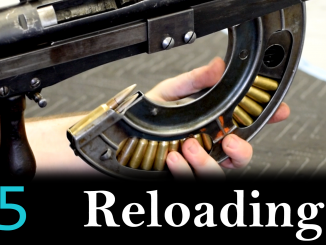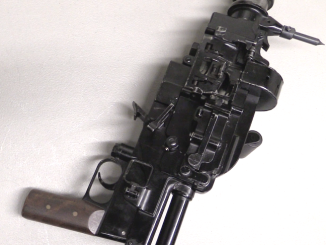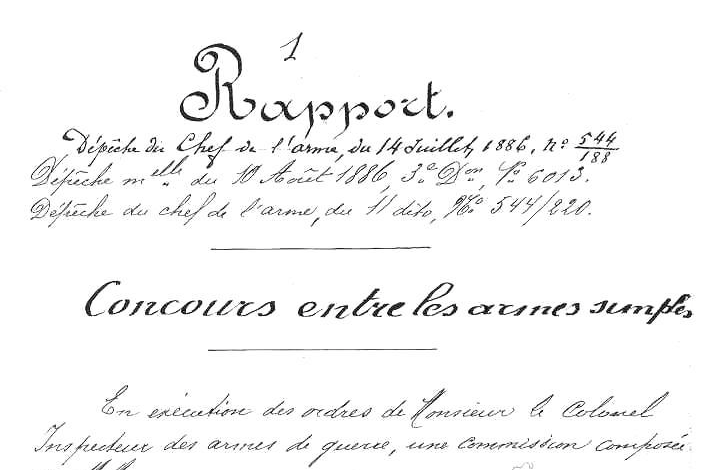We have looked at a couple different Madsen light machine guns previously, but until today I have not had the chance to do any shooting with a fully automatic example of one. So I am taking this 1924 Bulgarian contract example out to the range wth some ammo!
The Madsen is a really interesting gun for several reasons, both historically and mechanically. It was the first light machine gun actually put into real combat use, seeing service in the Russo-Japanese War. It would go on to be used in World War One, World War Two, and too many smaller conflicts to count, right through to staying in service with Brazilian police units into the 1990s if not 2000s. A service life that long would be impressive for any machine gun, but particularly so for such an early an unusual design.
Mechanically, the Madsen is best described as a short recoil falling block action. It uses a top-mounted magazine which is offset to the left, and which has no feed lips (they are machined into the receiver instead). Cartridges are pushed laterally into the action by a rotary block below the magazine, and then rammed into the chamber by a long swinging arm (definitely take a look at my previous video on the Madsen disassembly to see how this works in detail). The breechblock pivots at the rear and drops down to lock behind the cartridge when firing. It does fire from an open bolt, although the semiautomatic conversions available in th eUS are converted to closed-bolt operation.
Firing the Madsen, it is clear that one is working with an early design. The grip is not nearly as comfortable and intuitive as later guns, and the trigger pull is rather heavy. It remains a durable and effective weapon, however, with its unique eccentricities standing in for the polish that would come with later guns like the ZB-26.




“Madsen is a really interesting gun for several reasons, both historically and mechanically”
Also it is interesting that it evolved from self-loading rifle, also with top-feed, see 1st photo from top here: http://modernfirearms.net/machine/dk/madsen-e.html
Earlier example of self-loading rifle co-designed by Madsen (if I am not mistaken):
https://www.arma-dania.dk/public/timeline/_ad_gevar_view.php?editid1=92
Dansk Forsøgsrekylgevær (Selvladegevær M.1888)
If I am not mistaken, it states that 50 examples were made.
If it’s good enough to serve for the entire century then the development team got something right! Making the gun more ergonomic would be a matter of getting a pistol grip and adjusting the trigger control group. I would also advocate a fire stock or grip so that one does not hold the gun by the barrel shroud.
“getting a pistol grip and adjusting the trigger control group”
In reality it was not applied, even Let Maskingevær M/48 don’t have one:
https://www.arma-dania.dk/public/timeline/_ad_automatvaben_view.php?editid1=14
also I don’t see big advantage of implementing pistol grip in weapon fired from bipod.
It’s a bipod mounted LMG — your support hand hold is the buttstock *anyway*, and you can achieve a decent hold, either the “American” style of “hand over top, cheek against back of hand” or the “European” technique of cradling the toe of the buttstock, just the way the stock is configured now.
A pistol grip would he nice, and being able to hold the forend with the support hand would be useful during “assault” fire techniques, although you could also do what so many other good machineguns require and hold it by one leg of the bipod, if you wanted to do “walking fire”…
The Madsen was well ahead of it’s time, and you would be far from disarmed if you had one (in good repair, obviously – not some clapped out cow that’s been rattling around a succession of Third World warlords without maintenance, or even oil, for a few decades) in a combat zone today. Sure, newer guns are mostly better, but the Madsen ain’t bad, for a full poser magazine fed LMG… it’s no Zb26, but it’s far from an M1909 Benet-Mercie Machine Rifle, WWII Breda M30, or Chauchat!
Ian-
You’ll have to update your timeline… the Madsen is still in use in Rio, converted to 7.62mm NATO apparently… http://www.thefirearmblog.com/blog/2017/10/04/recent-images-rios-drug-war/
Another great video, Thanks!
“used in World War One”
In Russian it was used also as aviation machine gun, among other on Ilya Muromets
https://en.wikipedia.org/wiki/Sikorsky_Ilya_Muromets
probably first multi-engined bomber produced in quantity
And some other aeroplanes, see section Фотографии (photos) here:
http://www.airwar.ru/weapon/guns/madsen1902.html
From top to bottom:
4th, 5th, 6th – captured Albatros C.I
7th, 8th – Morane-Saulnier Type L
But “air” career of Madsen does not end in 1918.
http://www.airwar.ru/weapon/guns/madsen1927.html
After end of Great War, man named Hambroe was given task of adopting basic Madsen machine gun to various application, thus increasing potential market.
These were named with alphabet as follows:
α – light machine gun, 7,3 kg, 453 mm barrel, ability to use bayonet
β and γ – other barrels lengths
η – on tripod, 8,5 kg, 588 mm barrel, able of AA fire
ε – tank machine gun
Work on aviation version culminated in model 1927 (Danish designation, other might be found depending on users, but difference is mainly in caliber used). Special muzzle device and spring buffer were added resulting in Rate-of-Fire of 1000 rpm. This gun could be synchronized. Feeding from either metallic disintegrating belt or 50-round drum. Feeding only from left side. This gun was used in Scandinavian countries and some South American. Argentine used 7,65-mm and 11,35-mm version. Second use unique 11,35×62 mm cartridge (see photos section) developed by KYNOCH, which was much less powerful than say .50 Browning or 12,7×108, but allowed construction of small and light (for caliber) machine gun – 11,35 mm version mass feed from 100- or 200-belt, mass of gun was 10,5 kg, overall length 1280 mm, barrel 750 mm, Rate-of-Fire 900-1050 rpm, muzzle velocity 825 m/s (with 20 g bullet).
Municion has entry for that 11,35 mm cartridge:
http://www.municion.org/Madsen/11x62Madsen.htm
using bigger bullet might be explained by ability to pack more TRACER substance or HE filler. It was worth noting as it predates practice of necking-up cartridge (more generally: using bigger but slower projectile) for aircraft machine gun during World War II, for example in Germany – MG151 which from 15 mm become 20 mm weapon.
But 11,35 mm was not end in size, Madsen in 1920s created 20-mm auto-cannon: http://www.airwar.ru/weapon/guns/madsen1933.html
basically it was Madsen machine gun upscaled to 20×120 cartridge and equipped with hydraulic buffer. First demonstration for foreign attachés was in 1926, but failed to spark bigger attention – gun fired at moderate 180 rpm and was 50 kg heavy and also need some refining.
Later muzzle device was added increasing Rate-of-Fire to 300-400 rpm. Marketing was now mainly as AT or AA gun, various shells were developed (AP, HE, HE-T), feeding was from 10-round magazine or 60-round magazine or 100-round belt. As AA gun it will be used in limited numbers in various places during Second World War.
Anyway for making it more appealing for potential buyer Madsen decided to create 23-mm version (23×106 cartridge, heavier bullet, but same overall length, see photos section) which was even bit lighter (53 kg vs 55 kg). Rate of fire was 400 rpm. Feed from 100-round metal belt. It was exposed during Paris Aviation Exhibition 1936, soon orders arrive. Beyond “traditional” customers from South America, 4 examples (+5000 ammunition) were bought in 1937 by United States and tested on some prototypes (XP-38, F4F, XF5F-1) but found to be unreliable.
Chile bought 20 example for arming Breda Ba 65. France also bought few, but was content with reliable unlike United States. Most notable user of 23 mm Madsen autocannons was Siam (Thailand) which armed 25 examples Curtiss Hawk 75N with pair of that autocannons. These aeroplane were used in combat against French Indochina in 1941 and against Japanese invasion.
While never used on very big scale, it spawned some interest in 23 mm caliber, for example U.S. .90″ caliber (T1, T2, T3 and T4 guns).
And also 23 mm for Hispano-Suizo HS 407
http://www.municion.org/23/23x122Hs407.htm
Finland actually used the 20mm Madsen AA/AT gun in fairly significant numbers. In summer 1941 the Finnish Army had 360 guns, of which only 20 were on an AT mount.
As an AT gun the Madsen was inferior to the L-39 Lahti and other guns chambered in the 20×138mmB “Long Solothurn” cartridge. Accordingly, the Madsens were removed from AT duty in Spring 1942 and used as light coastal defense guns for the rest of the war.
A correction: actually only 20mm Madsen 200 guns in summer 1941, many of which were used by the Finnish Navy instead of Army. 360 guns would be correct for late 1943.
Am I correct that the markings for the selector lever are Bulgarian for:
Secure
Empty
Fire
?
Ian,
Early weapons had a “swivel” pivoting on the back of the trigger guard that could be turned up to prevent full travel of the trigger when semi-auto was required. So, apparently, short-pulling the trigger would also provide for single shots on those early weapons. I have suspected (but do not know for sure) that short stroking the trigger will will still provide semi-automatic fire on later built weapons. Did you try short-pulling the trigger?
It wasn’t just “didn’t know what to do with early LIGHT machine guns” because the heavy machine guns were used as if they were artillery pieces. Eventually the heavy machine gun mount went from a wheeled artillery mount to a tripod that broke down into several (barely manageable) man-portable loads for short distance transportation. An entire squad of six or more men were required to displace a heavy machine gun and a small ammunition supply–and don’t forget the water used to cool most heavy machine guns! In contrast, a light machine gun could be (barely) transported and handled by one man, though a crew of two to four would make the most out of the light machine gun. Reloading the light machine gun and carrying additional ammo and perhaps a spare barrel was much easier with two men, and two man machine gun teams had a smaller footprint, attracted less artillery and rifle fire than a big machine gun squad, and could manage (barely) to keep up with a rifle squad advancing.
There were two problems with light machine guns–military theorists tried to use them as if they were heavy machine guns (meaning using these guns as if they were the 75mm regimental field artillery gun) and lighter-weight machine rifles or automatic rifles were pressed into service as light machine guns. Light machine guns fired off bipods had a much shorter effective range than heavy machine guns and only a fraction of the fire volume. In the First World War it was common for a heavy machine gun to fire more than 6000 rounds in a single day, and using machine guns to interdict strategic points such as a crossroads at distances of more than 3000 meters was a standard tactic. In contrast the light machine gun had a mobility advantage–at a cost in sustained fire rate and in usable range. As the Germans and British both proved with their MG-34 and BREN, clamping a light machine gun on a tripod mount with enhanced aiming equipment did give the light machine gun the same reach as a heavy machine gun (no surprise–same rifle cartridge) but one heavy machine gun could deliver more bullets on target than several light machine guns firing at the same time.
During World War One mobility and short distance (rifle distance) fire power became more important than higher fire volume delivered at longer distances. In the British Army heavy machine guns were pooled into a Machine Gun Corps and used massively and light machine guns (the Lewis) were distributed at company level. France used quite a few Chauchat machine rifles that were integrated into French rifle squads, and their Hotchkiss heavy machine guns were used by higher echelons. Oversimplifying things, the light machine gun was mobile and the heavy machine gun put lots of bullets on target.
The Russians quite logically armed their cavalry with the Madsen after the Turn of the 20th Century. The light weight was a plus for mobile troops and the LMG’s comparative lack of sustained fire capability was not seen as a drawback, as cavalry was not intended to engage in infantry type firefights. I think it was carried on a horse led by a member of the gun team. carrying the gun and ammunition supply, not the individual trooper.
BTW, the Russians were not as backwards as some people think. They had observers in the American Civil War and Franco-Prussian War and based on what they reported, converted all their mounted troops to Dragoons, emphasizing the dismounted role. The horse was to give operational mobility.
Somewhere I have a now ancient manual on identifying VC and NVA weapons, I think it included the Madsen. Some are probably in use today in &diety knows what caliber in Ukraine.